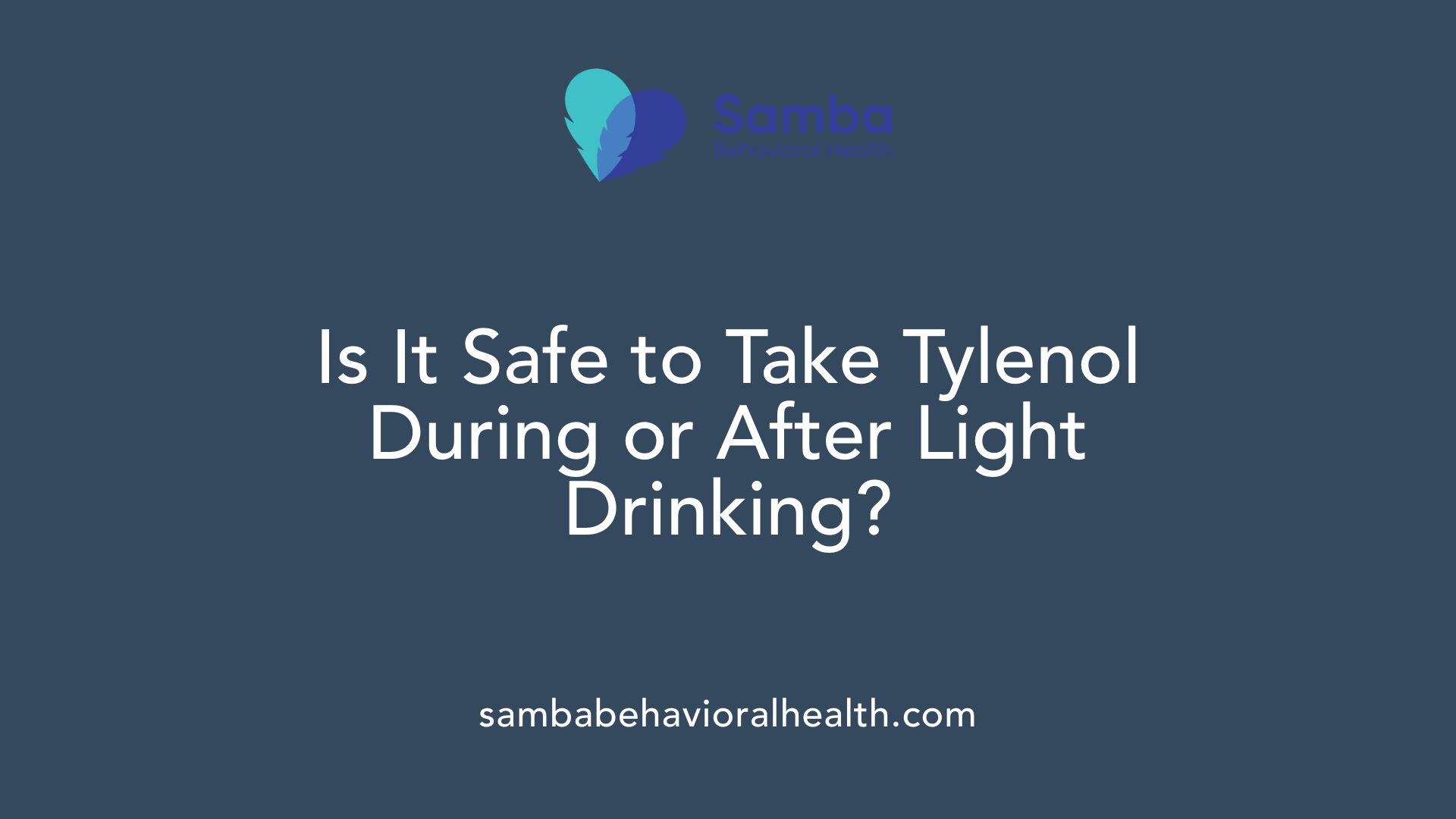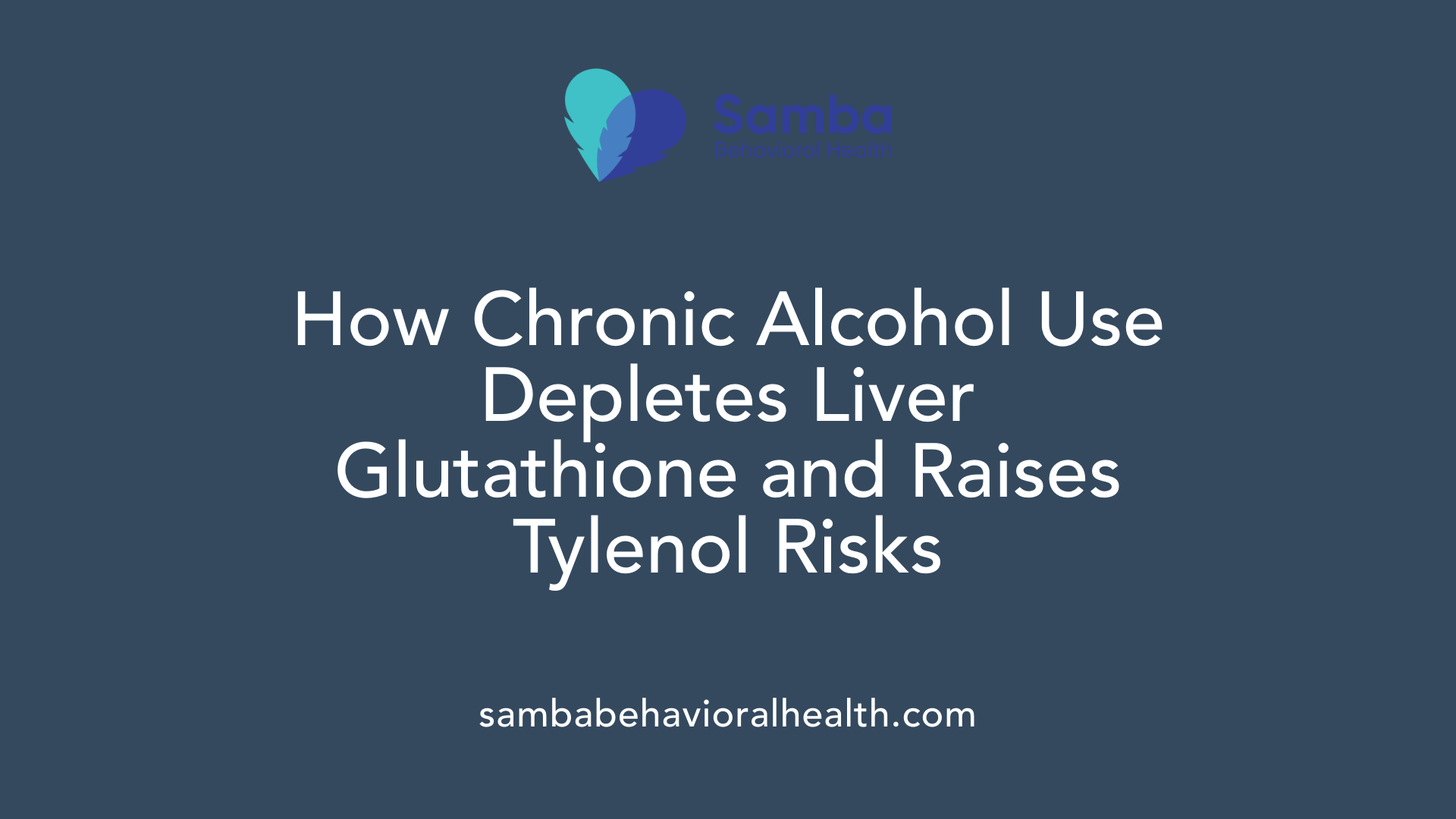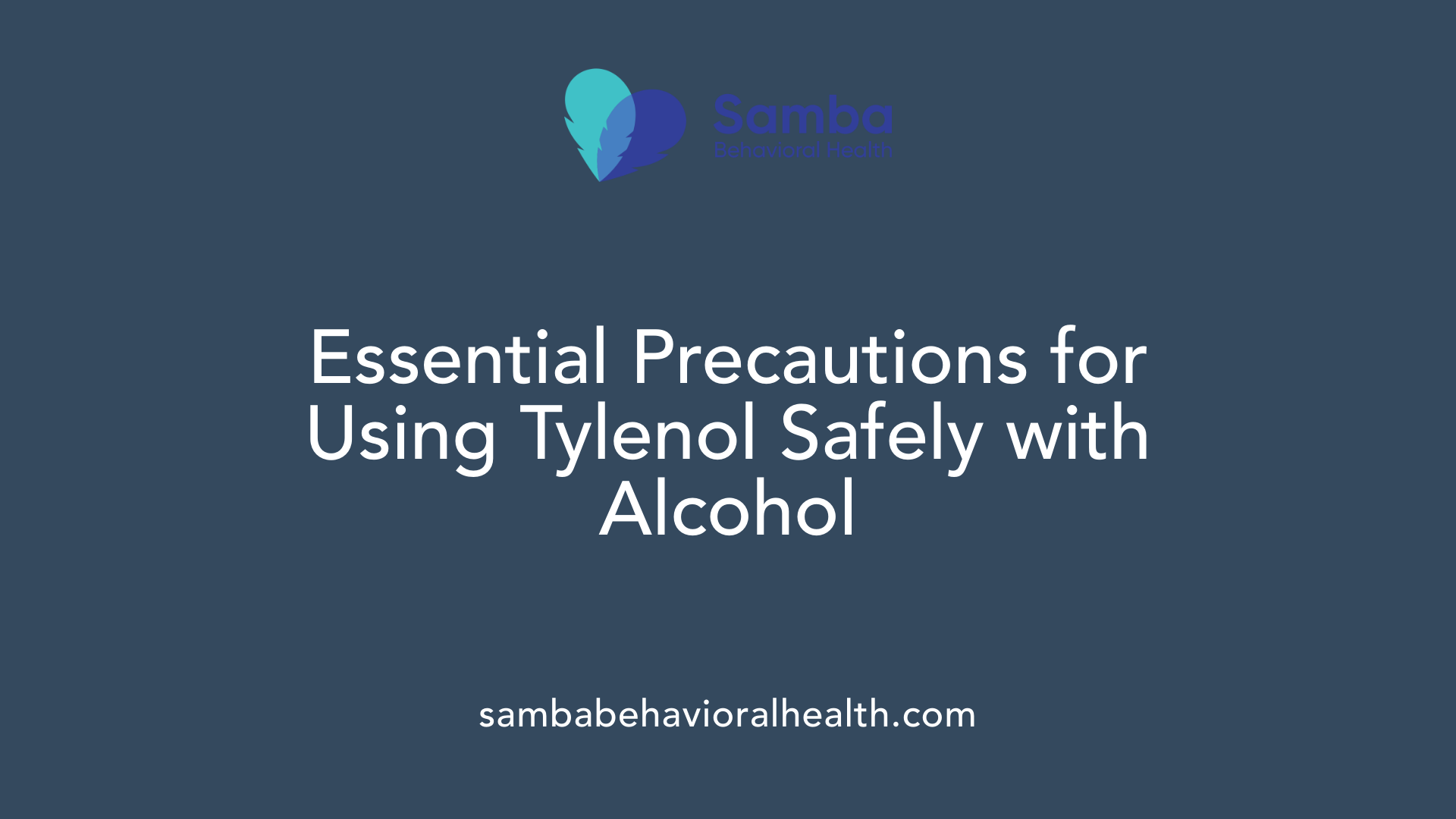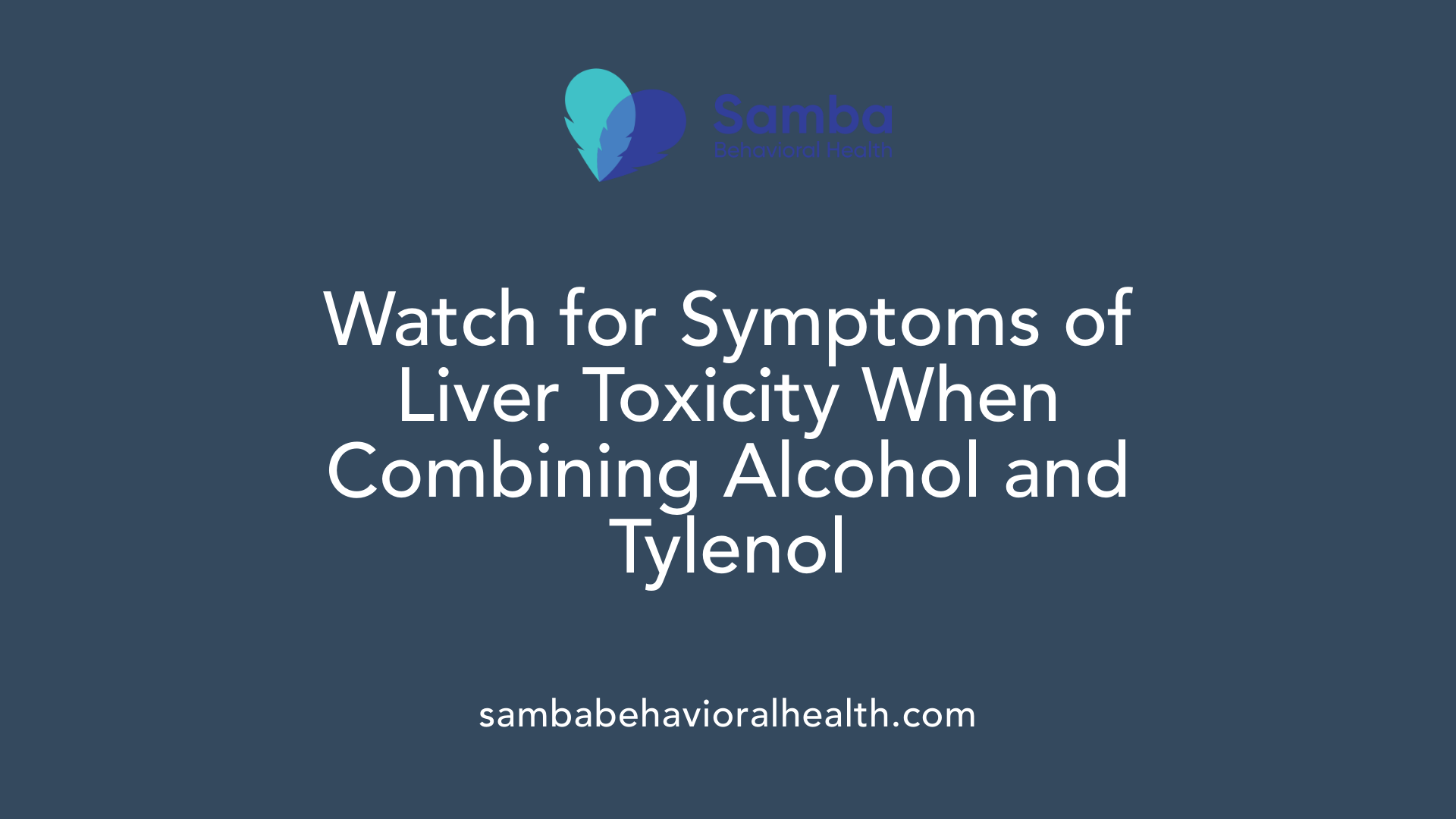Exploring Safety, Risks, and Precautions
Many people wonder whether it's safe to take Tylenol (acetaminophen) while consuming alcohol. While occasional, light drinking in conjunction with Tylenol may pose minimal risks for healthy individuals, repeated or heavy alcohol use can significantly increase the potential for liver injury and other health complications. This article delves into the scientific, medical, and safety considerations to help you understand when mixing alcohol and Tylenol is risky, what symptoms to watch for, and how to minimize harm.
Impact of Moderate Alcohol Use with Tylenol

Is it safe to take Tylenol during or after light drinking?
Taking a standard dose of acetaminophen (up to 1,000 mg every 4-6 hours, with a maximum of 4,000 mg daily) generally does not cause liver damage in healthy individuals when used during or shortly after a night of drinking. Light or moderate alcohol consumption, defined by the CDC as no more than one drink per day for women and two drinks per day for men, usually does not significantly increase the risk of liver problems if Tylenol is taken as directed.
However, it's important to be cautious. Combining Tylenol and alcohol—even at moderate levels—can impose extra stress on the liver because both substances are metabolized there. The liver converts acetaminophen into benign substances but also creates a small amount of a toxic compound called NAPQI. Glutathione, a natural antioxidant in the liver, helps neutralize this toxin.
When alcohol is consumed regularly or in high quantities, it depletes glutathione stores. This reduction impairs the liver’s ability to detoxify NAPQI, increasing the risk for liver damage even with normal Tylenol doses. While occasional light drinking with Tylenol hasn't been shown to cause serious harm, repeated or heavy alcohol use can significantly raise the risk.
How long should I wait to drink alcohol after taking Tylenol?
There is no strict, universally agreed-upon period to wait before drinking alcohol after taking Tylenol. Most health professionals recommend waiting at least 6 to 24 hours after consuming alcohol before taking acetaminophen. This window allows the body to process the alcohol and reduces the chance of overlapping metabolic stress on the liver.
For example, if you have had a drink or two, waiting at least 6 hours before taking Tylenol is advisable. If you have engaged in binge drinking or heavy alcohol use, it is safer to wait 12 to 24 hours after the alcohol effects have worn off. During this period, the liver recovers some of its glutathione reserves, decreasing the chance of toxicity.
Always consider individual health factors as well. People with pre-existing liver conditions, those on other medications, or individuals who consume alcohol heavily should consult their healthcare provider for personalized guidance. It’s especially important to be cautious in these cases to prevent severe liver damage or other complications.
The bottom line
In summary, taking Tylenol in moderation—up to the recommended daily limits—shortly after light drinking is generally safe in healthy individuals. However, to avoid risking liver damage, it’s best to wait at least several hours after alcohol consumption before taking acetaminophen. If you have any doubt or consume alcohol regularly or heavily, talking to a healthcare professional is the safest way to determine the best course of action.
Remember, other pain relief options like NSAIDs (ibuprofen, naproxen, aspirin) may sometimes be safer when alcohol has been consumed, but these also carry specific risks and should be used under medical advice, especially with alcohol consumption.
In all cases, careful adherence to dosing guidelines and awareness of your personal health status can help mitigate risks when combining alcohol with pain medications. Regularly consulting with healthcare providers about medication and alcohol use remains the best practice for safety.
Risks of Frequent or Heavy Alcohol and Tylenor Use

How chronic alcohol consumption depletes glutathione in the liver
Chronic drinking significantly affects the liver's ability to protect itself from toxins. A crucial component in this process is glutathione, a powerful antioxidant that neutralizes harmful substances. When alcohol is consumed heavily or regularly, it depletes glutathione stores in the liver. This reduction diminishes the organ's capacity to detoxify toxic substances, especially the harmful metabolite NAPQI produced when acetaminophen (Tylenol) is processed.
With lower glutathione levels, the liver becomes more vulnerable to damage from acetaminophen. Normally, the liver safely converts acetaminophen into benign compounds, with glutathione helping to eliminate the toxic NAPQI. When this protective mechanism is impaired due to alcohol depletion of glutathione, even standard doses of Tylenol can lead to liver injury.
Enhanced toxicity risk due to alcohol-induced enzyme activity
Alcohol intake influences specific liver enzymes that are responsible for drug metabolism. Notably, alcohol increases the activity of the enzyme CYP2E1. This enzymatic change accelerates the breakdown of acetaminophen into its toxic form, NAPQI, in higher amounts.
This process makes the toxic metabolite more abundant and more reactive, causing more damage to liver cells. The combination of increased NAPQI levels and decreased glutathione availability creates a perfect storm for liver toxicity. The prolonged presence of both alcohol and acetaminophen in the bloodstream, especially during and after heavy drinking, elevates the risk of significant liver injury.
What are the health risks of mixing alcohol and Tylenol?
Mixing alcohol and Tylenol (acetaminophen) can significantly increase the risk of liver damage and potential liver failure. Usually, if the dosage of acetaminophen is within recommended limits—up to 1,000 mg every 4-6 hours, not exceeding 4,000 mg per day—it may be safe in healthy individuals who consume alcohol in moderation. However, with heavy, regular, or binge drinking, this safety margin narrows considerably.
Heavy alcohol use leads to depletion of glutathione, diminishing the liver's ability to process and detoxify acetaminophen safely. This situation allows toxic NAPQI to accumulate, causing cellular damage within the liver. The consequences can be severe, including symptoms such as jaundice, upper right abdominal pain, confusion, dark urine, and in extreme cases, organ failure.
Moreover, combining alcohol and Tylenol without caution can mask early signs of overdose or toxicity, delaying treatment and increasing the risk of irreversible liver injury. Overdose on either substance, especially in combination, can be fatal.
To reduce danger, it is recommended to avoid using Tylenol during or shortly after heavy drinking episodes. Even in individuals who drink alcohol moderately, it is wise to follow dosing instructions diligently, stay within safe limits, and consult healthcare professionals if there are underlying liver problems or ongoing alcohol use disorder.
In summary, while a single dose of Tylenol taken in moderation amidst light alcohol consumption might be relatively safe for healthy adults, sustained or excessive alcohol intake substantially increases the danger of liver damage due to synergistic effects on liver enzyme activity and glutathione depletion. Awareness and cautious use are vital to prevent serious health outcomes.
Precautions and Safe Use Guidelines

What precautions should I take when using Tylenol with alcohol?
When it comes to using Tylenol (acetaminophen) alongside alcohol, caution is essential to safeguard your liver health. Both substances are processed primarily in the liver, and their combined use can put significant stress on this vital organ.
For healthy adults, moderate alcohol consumption—defined by the CDC as no more than one drink per day for women and two drinks per day for men—may be relatively safe if Tylenol is used exactly as directed. This typically means staying within the maximum recommended dosage of 4,000 mg of acetaminophen per day and not exceeding a duration of 10 days without medical guidance.
However, heavy drinking—defined as eight or more drinks weekly for women and fifteen or more for men—substantially increases the risk of liver damage. In such cases, it's best to avoid using Tylenol altogether until alcohol effects have fully worn off, which can take 12 to 24 hours. Regular binge drinking further amplifies this danger.
People with pre-existing liver conditions or those who consume alcohol heavily should only use Tylenol after consulting a healthcare provider. Combining high doses of Tylenol with heavy alcohol use can lead to liver failure, which may be life-threatening.
To minimize risks, always follow the dosing instructions carefully. Do not take more than the recommended dose, and do not use Tylenol for more than 10 days unless directed by a doctor. Eating food, drinking water, and avoiding alcohol immediately after taking Tylenol can also help protect your liver.
In case you notice symptoms such as jaundice (yellowing of the skin or eyes), abdominal pain, dark urine, confusion, or unexplained bruising, seek emergency medical attention immediately. These signs indicate liver toxicity, which can become severe if left untreated.
For individuals who regularly consume more than three drinks per day or have concerns about liver health, alternatives like NSAIDs (e.g., ibuprofen or aspirin) may be safer options for pain relief. Always consult with a healthcare professional before combining any medication with alcohol.
In summary, exercise caution: limit alcohol intake, adhere strictly to medication doses, and avoid alcohol if you have existing liver issues. Proper precautions can help prevent serious health consequences associated with the combination.
Recognizing Signs of Liver Toxicity and Overdose

What symptoms indicate toxicity or adverse effects from mixing alcohol and Tylenol?
Combining alcohol with acetaminophen (Tylenol) can increase the risk of liver damage, especially when taken in high doses or over prolonged periods. It is crucial to recognize the early warning signs of toxicity to seek prompt medical intervention.
Symptoms signaling potential liver injury include jaundice — a yellowing of the skin and eyes caused by high bilirubin levels. People may also experience upper right abdominal pain or tenderness, which suggests liver inflammation or damage. Dark urine, sometimes accompanied by blood, can be a sign that the liver's filtering ability is compromised.
Unexplained bruising or bleeding is another warning, indicating that liver dysfunction might be affecting blood clotting functions. Fatigue, confusion, and excessive sweating are common symptoms that point toward systemic effects of liver failure. Some individuals may encounter nausea, vomiting, or a loss of appetite, further indicating hepatic distress.
In addition, abdominal swelling could occur due to fluid buildup, and dizziness or weakness may also present themselves. When alcohol and Tylenol are used together, these symptoms can develop rapidly, and their severity can escalate to life-threatening stages.
The underlying reason for these symptoms relates to the formation of toxic metabolites like NAPQI, which increase when glutathione stores are depleted—something chronic alcohol consumption can exacerbate. This overload can overwhelm the liver's detoxification capacity, leading to hepatocellular injury.
Recognizing these signs early is vital. If you experience any of these symptoms after drinking alcohol and taking Tylenol, immediate medical attention is necessary to prevent irreversible liver damage or failure. Proper caution and prompt healthcare consultation can significantly reduce the risk of serious health outcomes.
Timing and Safety of Alcohol Consumption Post-Tylenol Intake
Is it safe to drink alcohol after taking Tylenol?
It is generally unsafe to consume alcohol while taking Tylenol (acetaminophen). Both substances are processed by the liver, and their combined presence can increase the risk of liver damage or toxicity. When alcohol is present, it can activate certain liver enzymes like CYP2E1, which increases the production of a harmful metabolite called NAPQI from Tylenol. Normally, the liver neutralizes NAPQI with glutathione, a protective substance, but chronic heavy alcohol use depletes glutathione stores, making liver cells more vulnerable to damage.
Even in healthy individuals, taking Tylenol in conjunction with alcohol—especially in excess—can cause a backlog in liver processing, heightening the risk of hepatotoxicity, or liver poisoning. While moderate alcohol consumption may be less risky if both are used within recommended limits, the safest approach is to avoid alcohol entirely during Tylenol treatment.
Experts recommend waiting at least 24 hours after taking Tylenol before drinking alcohol. This waiting period allows the medication to be metabolized and reduces the strain on the liver, decreasing the likelihood of liver injury.
Recognizing symptoms of liver toxicity is vital. These include jaundice (yellowing of skin and eyes), upper right abdominal pain, dark urine, nausea, confusion, and unexplained bruising. Immediate medical attention is necessary if any of these symptoms appear.
In summary, while some light to moderate alcohol use shortly after Tylenol may pose minimal risk in healthy individuals, the most prudent choice is to abstain from alcohol until the medication has fully cleared, typically after 24 hours. This approach helps protect your liver and reduces the risk of severe health complications.
How Alcohol Influences Tylenol Metabolism and Toxicity
How does alcohol interact with Tylenol in the body?
When alcohol and Tylenol (acetaminophen) are both processed in the liver, they can significantly influence each other's metabolism and the overall impact on health. Under normal circumstances, the liver handles small doses of acetaminophen safely by converting it into benign substances. However, alcohol changes this process.
One critical effect of alcohol, especially in heavy or chronic drinkers, is the activation of an enzyme called CYP2E1. This enzyme becomes more active with alcohol consumption, particularly in those who drink regularly or excessively. As CYP2E1 activity increases, it leads to an enhanced production of a toxic metabolite named NAPQI from acetaminophen.
NAPQI, in small amounts, is usually neutralized by glutathione, a natural antioxidant stored in the liver. However, alcohol consumption depletes glutathione reserves, making it harder for the body to detoxify NAPQI. This buildup can cause liver cells to be damaged or die, leading to hepatotoxicity or liver toxicity.
Unlike moderate alcohol use, which generally does not increase the risk when combined with recommended acetaminophen doses, chronic heavy drinking can increase the potential for liver harm, especially if acetaminophen is taken repeatedly or in high doses.
This interaction underscores the importance of cautious use: avoiding high doses of Tylenol and limiting alcohol intake if using these substances simultaneously. When in doubt, consulting a healthcare professional is recommended to prevent serious health complications.
Increased CYP2E1 enzyme activity in chronic drinkers
Chronic alcohol consumers often experience increased activity of the CYP2E1 enzyme. This enzyme’s role is to metabolize various substances, including alcohol and acetaminophen. In the case of acetaminophen, CYP2E1 converts it into NAPQI, which at high levels can be harmful.
Regular or heavy drinking causes CYP2E1 levels to rise, leading to more NAPQI formation during acetaminophen metabolism. Since glutathione depletes with ongoing alcohol use, the liver becomes less equipped to handle this toxic metabolite. As a result, the risk of liver damage is significantly heightened in chronic drinkers who take Tylenol.
Enhanced production of toxic NAPQI metabolite
The increased activity of CYP2E1 results in an increased production of NAPQI, the highly reactive and potentially damaging substance responsible for much of acetaminophen's hepatotoxicity. Normally, NAPQI is safely neutralized by glutathione, but with alcohol-induced glutathione depletion, the excess NAPQI can bind to liver cell proteins, causing oxidative stress and cell death.
This process can occur even with standard therapeutic doses of acetaminophen if alcohol consumption is heavy or chronic. The cumulative effect can result in severe liver injury or even failure.
Summarizing the interaction, the combined effects of increased CYP2E1 enzyme activity and glutathione depletion create a perfect storm for liver toxicity in individuals who consume alcohol regularly while taking acetaminophen. Awareness and moderation are vital to prevent serious health consequences.
Recent Studies and Clinical Findings
Study in Detoxification Clinics Showing No Increased Liver Toxicity with Recommended Tylenol Doses
Recent research provides reassuring insights into the safety of using acetaminophen (Tylenol) during recovery from alcohol use. A notable study involved 201 patients in a detoxification facility who were allowed to take 1000 mg of acetaminophen four times daily over a span of two days after ceasing alcohol consumption.
The researchers carefully monitored serum liver enzymes, specifically aspartate aminotransferase (AST) and alanine aminotransferase (ALT), which are indicators of liver health. The results showed no significant differences between those taking acetaminophen and those on a placebo, suggesting that, within the recommended dose limits, Tylenol does not increase liver toxicity risk in individuals recovering from alcohol use.
This study underscores that in controlled, short-term use, acetaminophen can be safe even shortly after alcohol consumption, provided the doses stay within the advised limits.
Monitoring of Liver Enzymes in Clinical Settings
Liver enzyme tests remain a primary method for detecting liver damage early. Healthcare professionals often measure AST and ALT levels to evaluate liver health in patients consuming alcohol, taking acetaminophen, or both.
In clinical settings, these tests help distinguish normal liver function from signs of hepatotoxicity — which can be indicated by elevated liver enzymes. Elevations could reflect inflammation, cell damage, or liver stress often caused by toxins, overdose, or long-term damage.
Patients recovering from alcohol use or with ongoing alcohol intake should have regular monitoring if they need to use acetaminophen for pain management. Elevated enzymes can prompt timely interventions to prevent serious outcomes like liver failure.
How Both Substances Affect the Liver
The liver metabolizes both alcohol and acetaminophen using common pathways, mainly involving enzymes like CYP2E1. When alcohol is present, especially in heavy or chronic use, it increases the activity of CYP2E1, which escalates the production of a toxic metabolite called NAPQI from acetaminophen.
NAPQI is normally neutralized by the liver’s glutathione reserves. However, chronic alcohol consumption depletes glutathione, leaving the liver vulnerable to toxin buildup and damage.
Therefore, in individuals with heavy drinking habits, even standard doses of acetaminophen might pose risks. Good clinical management involves assessing alcohol use history, monitoring liver function, and choosing pain treatment options accordingly.
Practical Recommendations
Based on current evidence, healthcare providers recommend that healthy individuals following the recommended acetaminophen dosages, such as not exceeding 4 grams per day, do not experience significant liver issues—even if they have recently consumed alcohol.
However, in cases of binge drinking, heavy alcohol use, or pre-existing liver conditions, it is advisable to wait at least 12 to 24 hours after alcohol effects have subsided before taking Tylenol.
Furthermore, routine monitoring of liver enzymes can help detect early signs of stress or damage, especially in vulnerable populations.
Table 1: Summary of Important Points Relevant to Acetaminophen and Alcohol Metabolism
| Aspect | Details | Additional Notes |
|---|---|---|
| Alcohol Consumption Levels | Moderate: 1 drink/day (women), 2 drinks/day (men); Heavy: ≥8 drinks/week (women), ≥15 drinks/week (men) | Regular moderate drinking typically safe for healthy adults |
| Recommended Tylenol Dose | Up to 4,000 mg per day; lower doses recommended for those with liver concerns | Exceeding this increases risk of hepatotoxicity |
| Time to Wait Before Taking Tylenol | Generally at least 12-24 hours after heavy drinking | In heavy or binge drinkers, waiting is safer |
| Monitoring Tools | AST, ALT liver enzymes | Elevated levels indicate potential hepatotoxicity |
| Mechanism of Risk | Increased CYP2E1 activity and glutathione depletion | Increases risk of toxic metabolite buildup |
Overall Implications
These clinical findings support that, when used responsibly within recommended guidelines, acetaminophen remains a safe pain relief option even after alcohol intake. Nevertheless, individual health status, drinking habits, and medication use should always be considered.
Consulting healthcare providers for personalized advice is ideal, especially for individuals with ongoing alcohol use disorder or pre-existing liver issues. Regular monitoring and cautious dosing are essential strategies to prevent adverse outcomes.
By understanding these recent clinical insights, both clinicians and patients can make safer decisions in managing pain and minimizing potential liver risks associated with alcohol and acetaminophen co-use.
Summary and Final Recommendations
How important is adherence to dosing and timing guidelines?
Taking acetaminophen (Tylenol) in accordance with the recommended doses and timing is crucial to minimize liver risk. The general guidelines suggest not exceeding 3,000 mg to 4,000 mg per day and avoiding use for more than 10 days unless directed by a healthcare provider. When it comes to alcohol, waiting at least 12 to 24 hours after heavy or binge drinking before taking Tylenol is advised. These precautions help prevent accumulation of toxic metabolites and reduce strain on the liver.
Using Tylenol precisely as directed, combined with moderation in alcohol consumption, helps protect against severe liver injury or failure. Always read and follow the medication label instructions, and consult your healthcare provider if you have doubts or health concerns.
Why should alcohol consumption be avoided or moderated when taking Tylenol?
Both alcohol and acetaminophen are processed in the liver, and their combination can increase the risk of liver damage. Moderate alcohol use—no more than one drink daily for women and two for men—may be relatively safe for healthy individuals when Tylenol is taken as directed. However, heavy drinking, binge episodes, or chronic alcohol consumption depletes liver glutathione, an essential protective substance.
When glutathione stores are low, the toxic byproduct NAPQI from acetaminophen metabolism accumulates, potentiating liver injury. Symptoms such as jaundice, upper right abdominal pain, dark urine, and confusion are signs of toxicity requiring immediate medical attention. To stay safe, avoid combining heavy alcohol use with Tylenol, especially in doses exceeding recommended limits.
When should you consult a healthcare professional for personalized advice?
Individuals with existing liver conditions, those who consume alcohol heavily or regularly, or who have other health issues should seek medical guidance before using acetaminophen. People over 65, women who are pregnant, or those with a history of alcohol use disorder are at higher risk of toxicity.
Discuss your alcohol habits and medication plans with a healthcare provider to tailor safe usage strategies. For example, alternative pain relief options like NSAIDs (e.g., ibuprofen or naproxen) might be safer, but they also carry their own risks, such as gastrointestinal bleeding.
In special situations—such as recent heavy drinking, ongoing alcohol problems, or if you're on multiple medications—professional guidance ensures safe pain management without risking liver damage.
Final safety tips
- Always adhere to dosing instructions and avoid exceeding the maximum daily limit.
- Wait at least 12-24 hours after heavy drinking before taking Tylenol.
- Limit alcohol intake to moderate levels—no more than 1 drink per day for women or 2 for men—when using Tylenol.
- Be vigilant for signs of liver damage, including jaundice, pain, and confusion.
- Consult with a healthcare professional for personalized advice, particularly if alcohol use or health conditions are a concern.
Additional insights
Recent clinical studies involving individuals in detoxification settings have shown that taking up to 4 grams of acetaminophen daily does not significantly increase the risk of liver injury in recovering alcohol users, provided it is used as directed. Still, this does not imply safety with excessive or prolonged use.
By following proper guidance, monitoring your alcohol intake, and consulting healthcare professionals as needed, you can effectively manage pain while minimizing health risks associated with combining Tylenol and alcohol.
Final Thoughts on Safe Use and Risks
While occasional light drinking in conjunction with Tylenol may pose minimal risks for healthy adults, heavy or frequent alcohol consumption can drastically increase the danger of liver damage, toxicity, and severe health consequences. It’s essential to follow recommended guidelines, be aware of symptoms of toxicity, and seek medical advice if unsure. Protecting your liver health involves cautious use of both substances and consulting with healthcare professionals for personalized recommendations.
References
- Is Acetaminophen Safe To Take When You're Drinking?
- Can You Drink on Tylenol? | The Recovery Village Columbus
- Acetaminophen (Tylenol) and Alcohol - Healthline
- Acetaminophen use in patients who drink alcohol: current study ...
- Alcohol & Tylenol: Is It Safe to Take Acetaminophen When Drinking?
- Alcohol-Medication Interactions: Potentially Dangerous Mixes
- Can You Take Tylenol with Alcohol? | Acetaminophen & Alcohol
